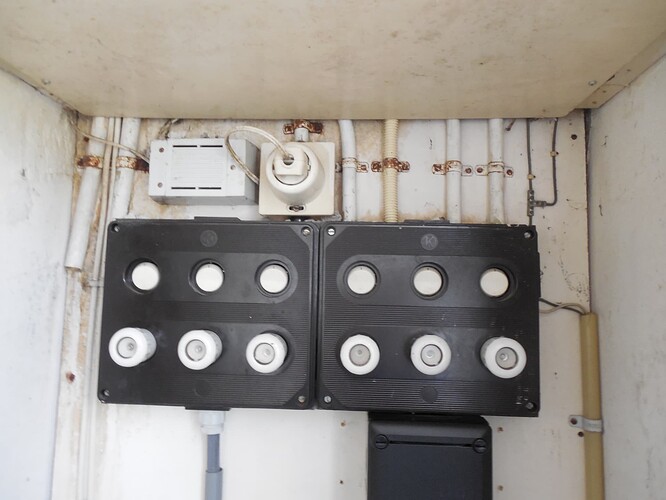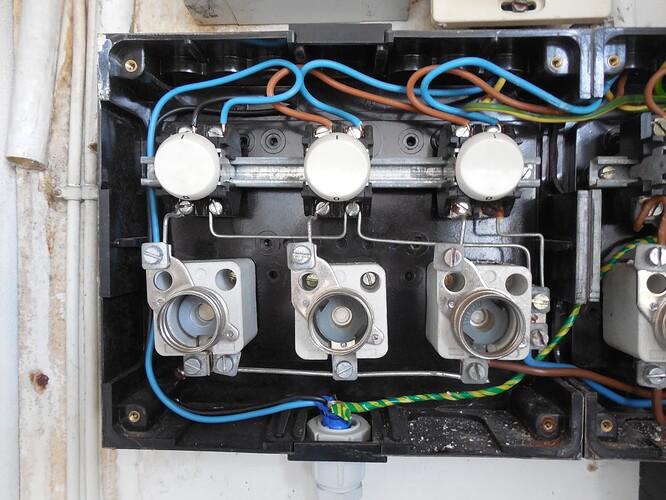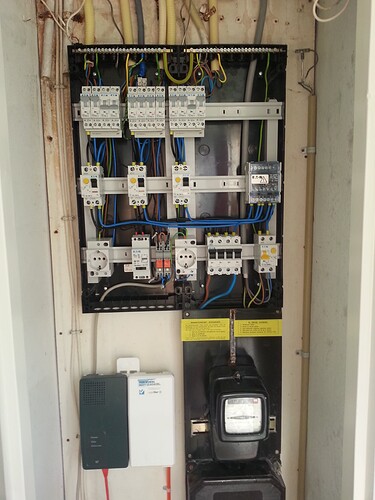I’ve started a new thread here EmonTx4 Documentation specifically for documentation updates.
I have some curious design questions, which may sound critical, but my intend is absolutely not to be rude or anything ![]()
Why the need for the separate emonVs? Putting all those electronics in the same housing would make the device simpler and possible cheaper? (I’m currently looking at the https://community.openenergymonitor.org/t/emporia-vue-2-alternate-firmware PCB design and think they solved some issues quite elegantly; I do not own one ![]() ). I know for a start-up getting all that compliance and EMC done is a big PITA, but since you are already designing your own PSU, what’s the reason now?
). I know for a start-up getting all that compliance and EMC done is a big PITA, but since you are already designing your own PSU, what’s the reason now?
Why the galvanic isolation on the voltage input? The Emporia doesn’t do it; and they are certified to sell world-wide. I can get it in mainland EU, and NA. Are transformers that more accurate then a few big resistors? I think in the end, you still end up with a scaled voltage?
0.333V CT’s seem to be somewhat common. Emporia uses them, I’ve seen them @ $work in our product. But I can’t wrap my head around the sensitivty/accuracy here. 0.333V CT’s would be 666mV across the range, right? But that’s not RMS, so we’ll add about half (napkin style) to get to 999mV or 1V for the CT output. If we VREF is 3v3 that’s a lot of lost resolution? We want to offset the CT’s to make sure they are always positive; e.g. VREF/2. So we would have signals from 1V15 - 2V15.
Looking at Getting the most out of the SAM D21's ADC - Stargirl (Thea) Flowers we actually see however, the the ADC is not so amazing generally. While this speaks of the ATsamd21, I bet that most ADC’s behave more or less the same. What’s interesting to note here, is that the ADC behaves more poorly in the lower half then in the upper half. The emporia seems to account for that by using 1v8 as the offset voltage, bringing that voltage swing to 1v3 - 2v3. Though in reality it’s probably ore like 1v5 - 2v1 looking at https://www.falstad.com/circuit/circuitjs.html?ctz=CQAgjCAMB0l3BWcAmWDLMgZgBxmcgCxg4CcS6IShWVApgLRhgBQATiKQGwhbKc9uUEJnjsBEoWC6RhyAOxwWAYwnTZQgoTnRR8fQeSMcUaFkhciOQpfldC3BHdNxWAJQlbP8-rNmFZMGgcX2EYBBYAeTUZcFJ+dXAoFgA3Xn4vPglAkFiYLAKw0wiAd3TJQR5IFjLNInKvaoBzCSyhP2SAexBte2F8ZFJZVDAEQekx7h8hhRdXOSpeFiA for example. Sadly for the atsamd21 at least, the dynamic range of the ADC doesn’t seem to be specified …
Still, I wonder would it not be worth-while to use a CT at 666mV. I’ve been eyeing the https://talema.com/products/az-series-flying-lead-current-transformer/ for example, and the 25 amp model would be good for 16 amps (24 amps RMS) would give 1.5 p2p so 3V0. Of course in this case we’d be in the ‘dirty region’ of the ADC, so we’d need all the tricks on that earlier page, so maybe the talema CT is just a little too much maybe?
Another option would be to use an input gain of 2, but that would actually introduce noise too … or use smaller reference voltages I suppose …
Finally, I really dislike clamp CT’s personally. They take up a lot of space, and bring lots of accuracy risks due poor mating of the clamp. Will solid ring coils ever be an option? They tend to be much smaller … For example I really like the MLG-WST-0200 30 amp https://www.measurlogic.com/product/mlg-wst-solid-core-ct-333mv-output/ on paper, but not buyable for mere mortals (afaik an OEM only product) (hence why I was looking at the talema ones, as digikey stocks those …)
With every respect, I can’t see Glyn & Trystan changing anything at this late stage.
Don’t you means cores? Personally, I don’t like people calling split-core c.t’s “clamps” - because they’re not. You clearly don’t understand either the legal ramifications in various countries of installing c.t’s, how c.t’s work with the sensing node, or both, if you need to ask this.
Thanks for the input and questions @oliv3r . As ever we are in a process of continuous development here and we will be considering our next steps again soon once we’re out of the initial delivery stage with the emonTx4.
We are using an analog reference at 1.024V in order to get a good match with the 333mV CT sensors. The 333mV CT sensors seem to be the most common size giving us the wider range of options. We are using a precision voltage reference MCP1502 0.1% in order to calibrate the internal analog reference on the AVR-DB.
I really like the Talema range that you linked (https://talema.com/products/az-series-flying-lead-current-transformer/), we have a number of these in the office for testing.
That said the new range of Echun CT’s that we are stocking have a much more solid ‘mating’ of the cores. Their accuracy is also much better than the YHDC CT’s we were using. Their accuracy is also better at 333mV than higher voltage outputs.
The benefit with split core CT’s is that it’s safer for the user to install them - which is the primary reason we use split core CT sensors.
I don’t think they should. These are just design questions I have on the tx4, which are influencing my purchasing decisions. Also, I think it’s much better to discus these in the open, rather then just go somewhere else, right? In the end, we all learn a little bit from critique generally ![]()
Hah, that’s a sad typo. CT Coils, solid core ring, type to fast, and in your mind it becomes solid coil, oops.
There’s no legal problems atleast in the netherlands, and I doubt in other european countries as far as I know, by installing Solid Core Current Transformer Coils afaik. Obviously, I wouldn’t put them Between the mains and the main shutoff. But after the shutoff, it’s safe and fine. Even installing them before the mains switch, there’s still the ‘sort of switch’ of the meter, and the main fuses.
Obviously, I understand you have to de-energize the whole panel, remove wires, run the wires through the cores, an reconnect things again. Not ideal for installers, not a problem for me, as I don’t mind taking the time. Since I’ve done my own wiring panel, I hope I will figure this out ![]() Here’s a pic of the panel as it is now, though I want to change a few things with some remoddeling of the home.
Here’s a pic of the panel as it is now, though I want to change a few things with some remoddeling of the home.
Before:
Note the rust on those wires, which actually caused some issues obviously
After:
The brown/blue wires entering from the bottom right is something I wouldn’t touch of course, including that switch (the main on/off switch). And yes, I had prepared everything for 3 phases, but haven’t had it hooked up yet. I do have 3 phases entering the house, but the meter is single phase.
I agree that using solid core’s in the US where they have to be placed on the bus-bar/incoming lines, that’s dangerous, as you’d be working on live-wires.
Also, I was thinking of it as an option, not for everyone …
So now my lack of understanding pops by ![]() Afaik, as mentioned above, we are ‘raising’ the voltage of the CT coils which are -0.333V ~ +0.333V to half 3v3, via the 1v65 aref, to ensure we don’t have any negative voltages on the adc input, correct? But if 1v65 (or 1v8) is used, then you’d be exceeding your 1v024 reference? What am I missing here conceptually?
Afaik, as mentioned above, we are ‘raising’ the voltage of the CT coils which are -0.333V ~ +0.333V to half 3v3, via the 1v65 aref, to ensure we don’t have any negative voltages on the adc input, correct? But if 1v65 (or 1v8) is used, then you’d be exceeding your 1v024 reference? What am I missing here conceptually?
I cannot disagree, but then I’d like at least to have the option. Also, again, size ![]() I understand in the UK that might be less of an issue, though I’ve seen some posts here where the space was super cramped. The clamps just take considerable more space.
I understand in the UK that might be less of an issue, though I’ve seen some posts here where the space was super cramped. The clamps just take considerable more space.
If you start to offer the talema range as option in your store though (after testing); that would be super interesting!
Hope you can at some point also cover my other questions ![]()
Thanks, for your thoughts so far!
A principal reason for choosing 0.333 V output c.t’s was their ubiquity - both as split-core and ring-core. There’s absolutely no reason why a user cannot use a set of ring-core c.t’s with any emonTx, nor is there any reason to use only a specific 100 A : 50 mA c.t with the emonTx V2 & V3, so long as the correct burden is chosen and the c.t. is not overloaded by the output voltage requirement.
In the UK, the “meter tails” between the suppliers fuse/neutral link and meter, and between the meter and the “consumer unit” (in UK parlance) or if you have one, an isolating switch, are sealed and you incur the ire of the supplier if the seals are broken. This is why split-core c.t’s are necessary for whole-house monitoring. I’ve been recommending some of the Talema range for some time, in appropriate circumstances.
The bias voltage is very close to 0.512V (half 1.024V aref). Hence we are in the correct range for the 0.333V CT, 0.333V rms x sqrt(2) = 0.470V mid rail to peak and 0.942V peak to peak, does that make sense?
Is that the correct term yea? Bias voltage? Right, i remember seeing a post in this thread that you where planning to use a precision 1.65V bias voltage, which is of course half of 3v3, so that indeed is my confusion. Using the internal 1024 reference, and calibrating that ‘at the factory’ makes a lot of sense. pro tip; keep a copy of the calibration data in your manufacturing database for future reference ![]()
So then, 0.333V over 1024/2 should be pretty good; you avoid the ADC ‘dead zones’ nicely while still being pretty good within range …
Great ![]()
Yes bias is the right term. You may have seen a mention of a 1.8V precision reference? we are actually using this external reference source (MCP1502 chip 0.1% tolerance) with a voltage divider (0.1% tolerance) to give 0.9V (0.2% tolerance). That is then read by the ADC on the AVR-DB to calibrate the internal analog reference. The MCP1502 precision reference chip is included on every board to do this.
Ideally the AVR-DB would accept an external 1.024V precision reference directly but unfortunately the external reference is limited to 1.8V, hence the workaround is to use the internal 1.024V voltage reference of the AVR-DB chip but calibrate it by reading the voltage of an external precision reference.
That’s a great blog by Stargirl Thea, thanks for that!
That adds a considerable amount to your BoM doesn’t it? Is it really needed to use a chip for the longevity of the device, do you expect a lot of drift over the years? I would have figured it’s much cheaper to calibrate it once in the factory store the calibration factory in the eeprom instead.
perhaps, I cant say with certainty yet but if it turned out a factory calibration was sufficient we could that in future. The Bom impact is ~£1 so it’s not huge but also not insignificant either.
Two points there: Can you estimate the cost of individually calibrating each unit, and the follow-up is, what happens if the user has a sketch that happens to overwrite the calibration in EEPROM? Will it need the calibration to be written on a label instead/as well, and how much will that add to the cost? The realistic cost in terms of semi-skilled labour, by the time overheads and taxes are taken into account, means £1 buys only a few minutes, so the precision reference might well be cheaper unless the calibration process is fully automated.
Im sure you are right @Robert.Wall that makes a lot of sense.
Received my brand spanking new Tx V4 and emonVS last week - thanks for the speedy delivery.
Quick question on the emonVS - that’s a chunky mains lead that you guys are using - I guess it’s just the cheapest lead with a plug on to keep costs down.
I’m assuming I can replace it with a slightly more manageable one, lower rated and more flexible. But is the earth needed, or can I use a twin core cable?
Simon
Hi Simon, the emonVS required an earth as a reference for monitoring, the cable we used has 1mm^2 conductors. The emonVS requires very little current, feel free to wire your own plug using thinner cable, but make sure the earth is connected (three-core cable required) and a suitable rated fuse is used. Or hardware the unit from a FCU or low rated MCB.
I bet you couldn’t have found a beefier one!! ![]()
Thanks for the info re the earth connection - I’ll find some lower rated flexible 3 core.
Simon
One for the docs, I’d suggest ![]()
@glyn.hudson - you didn’t look very far https://cpc.farnell.com/c/electrical-lighting/mains-power-leads?st=1mm+plug+to+bare+ends
There’s also this in 3-core 0.75 mm²
https://cpc.farnell.com/w/c/electrical-lighting/mains-power-leads?connector-type-a=mains-plug-uk&connector-type-b=free-end¤t-rating=5a
Even better, although more expensive (2m rather than 1m)
![]()
OK, no stock until the back end of February:
https://cpc.farnell.com/pro-elec/pel01284/uk-plug-to-open-end-0-75mm-black/dp/PL16106?st=uk%20mains%20plug%20to%20bare%20ends%200.75mm2%201m


